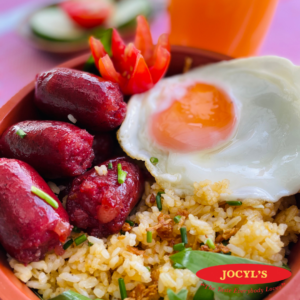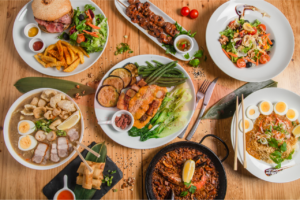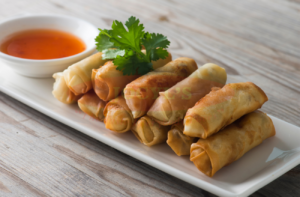
About Us
Jocyl's Food Products (a.k.a "Chorizo de Kalibo") is a bold and forward-thinking company whose goals are set to create surprising ways of developing and promoting our products. We are entrepreneurial and visionary in producing and marketing the best chorizo and other food products from our hometown - Kalibo, Aklan, Philippines.
About UsContact Info
- Tigayon Highway, Barangay Tigayon, Kalibo, Aklan
- +63362628688
- jocylsfoods@gmail.com
- Tigayon Highway, Barangay Tigayon, Kalibo, Aklan
- jocylsfoods@gmail.com
- +63362628688

From Adobo to Sinigang: The History and Evolution of Popular Filipino Dishes
-
Jocyl's Food Products > Blog > Food > From Adobo to Sinigang: The History and Evolution of Popular Filipino Dishes
Introduction to Filipino Dishes
Filipino cuisine is known for its bold flavors, colorful presentation, and unique blend of Eastern and Western influences. From adobo to sinigang, Filipino dishes have become increasingly popular around the world. In this article, we will explore the history and evolution of some of the most popular Filipino dishes, including their cultural significance and how they have evolved over time.
History of Filipino Dishes
To understand the history of Filipino cuisine, it is important to first look at the country’s colonial past. The Philippines was under Spanish colonial rule for over 300 years, which heavily influenced the country’s cuisine. Spanish dishes such as paella, arroz caldo, and lechon (roast pig) were introduced to the Philippines and were eventually incorporated into local cuisine.
In addition to Spanish influences, the Philippines was also under American occupation for several decades. This led to the introduction of American fast food chains such as McDonald’s and KFC, which have become popular in the Philippines today. However, despite these foreign influences, Filipino cuisine has retained its unique identity and flavors.
Popular Filipino Dishes
1. Adobo
Adobo is perhaps the most well-known Filipino dish, and for good reason. It is a simple yet flavorful dish that consists of meat (usually pork or chicken) marinated in a mixture of vinegar, soy sauce, garlic, and other spices. The meat is then simmered in the marinade until it is tender and infused with flavor. Adobo has been a staple in Filipino households for generations and is often served with rice.
2. Sinigang
Sinigang is a sour soup that is typically made with pork, beef, or seafood, and flavored with tamarind or other souring agents such as kamias or guava. Vegetables such as okra, eggplant, and radish are also commonly added to the soup. The sourness of the tamarind or other souring agents is balanced by the sweetness of the vegetables, resulting in a delicious and savory soup that is enjoyed by Filipinos all over the country.
3. Kare-kare
Kare-kare is a stew made with oxtail, beef, or pork, cooked in a peanut-based sauce. Vegetables such as eggplant, string beans, and bok choy are also added to the stew. Kare-kare is traditionally served with bagoong, a fermented shrimp paste that adds an extra layer of flavor to the dish. Kare-kare is often reserved for special occasions such as fiestas or family gatherings, and is considered a dish that shows off the cook’s skill in the kitchen.
4. Lechon
Lechon is a roast pig that is traditionally served whole on a spit. The pig is stuffed with herbs and spices and roasted over an open fire until the skin is crispy and the meat is tender and flavorful. Lechon is a popular dish for special occasions such as Christmas, weddings, and fiestas. In recent years, variations of lechon such as lechon belly (roasted pork belly) and lechon manok (roast chicken) have also become popular.
Evolution of Filipino Dishes
While traditional Filipino dishes such as adobo and sinigang have remained popular over the years, Filipino cuisine has also undergone some evolution to adapt to changing tastes and cultural influences. Here are some examples:
1. Fusion Cuisine
With globalization and the rise of food trends, Filipino chefs have started to incorporate foreign flavors and techniques into their dishes. This has led to the rise of fusion cuisine, which combines Filipino flavors with those from other countries such as Japan, Korea, and the United States. For example, restaurants in Manila are now serving sushi rolls with adobo filling, or kimchi fried rice with longganisa (Filipino sausage).
2. Healthier Options
With a growing awareness of the importance of healthy eating, Filipino cuisine has also evolved to include healthier options. For example, instead of using pork or beef in dishes like sinigang, restaurants and home cooks now offer fish or tofu as alternatives. Salad bars that feature local vegetables and fruits have also become more popular, and vegan and vegetarian restaurants have sprouted up in major cities.
3. Street Food Reinvented Filipino Dishes
Filipino street food has always been a staple of the country’s food scene, but in recent years, it has undergone a reinvention. Food trucks and outdoor markets are now serving up elevated versions of classic street food such as isaw (grilled chicken intestines), kwek-kwek (deep-fried quail eggs), and fish balls. These reinvented versions feature unique dipping sauces, creative presentation, and higher-quality ingredients.
Conclusion – Filipino Dishes
Filipino cuisine has a rich history that is reflected in its bold flavors and unique combinations of ingredients. From its Spanish and American influences to its evolving fusion cuisine and street food reinvention, Filipino cuisine has adapted and evolved to cater to changing tastes and cultural influences. As more people around the world discover the joys of Filipino cuisine, we can expect to see even more innovation and evolution in the years to come.
Tips for Cooking Filipino Dishes
If you’re interested in trying your hand at cooking Filipino dishes, here are some tips to keep in mind:
1. Invest in a good rice cooker
Rice is a staple in Filipino cuisine, and having a reliable rice cooker is essential for achieving perfect, fluffy rice every time. Look for a rice cooker that has a non-stick inner pot, a keep-warm function, and a measuring cup and serving spatula.
2. Use vinegar and soy sauce
Vinegar and soy sauce are the key ingredients in adobo, one of the most beloved Filipino dishes. Look for Filipino-style vinegar and soy sauce at your local Asian grocery store, as these have a different flavor profile than their Western counterparts.
3. Embrace sourness
Many Filipino dishes, such as sinigang and paksiw, rely on souring agents like tamarind, kamias, or calamansi for their signature tangy flavor. Don’t be afraid to experiment with different souring agents and find the ones that you like best.
4. Don’t forget the bagoong
Bagoong, a fermented shrimp paste, is a condiment that is often served alongside dishes like kare-kare and grilled seafood. It has a pungent odor and flavor that may take some getting used to, but it adds an umami-rich depth of flavor to dishes.
5. Experiment with local ingredients
Filipino cuisine is rich in local ingredients that may not be readily available outside of the Philippines. However, you can experiment with similar ingredients that are available in your area. For example, if you can’t find malunggay leaves, you can substitute spinach or kale.
6. Learn how to cook rice and noodles
Rice and noodles are the foundations of many Filipino dishes, so it’s important to know how to cook them properly. To cook rice, rinse it several times until the water runs clear, then add it to your rice cooker with the appropriate amount of water. For noodles, follow the package instructions for boiling or soaking.
7. Master the art of adobo
Adobo is one of the most beloved Filipino dishes, and every Filipino family has their own version of this classic dish. To make adobo, marinate your protein of choice (pork, chicken, or even tofu) in a mixture of vinegar, soy sauce, garlic, and bay leaves. Then, simmer the mixture until the meat is tender and the sauce has thickened.
8. Use a mortar and pestle
Many Filipino dishes require the use of a mortar and pestle to grind spices or create pastes. Invest in a sturdy mortar and pestle made of granite or marble, and use it to grind up garlic, ginger, peppercorns, and other ingredients.
9. Don’t forget dessert
Filipino desserts are just as delicious and varied as the main dishes. Try making halo-halo, a shaved ice dessert topped with sweet beans, jellies, and evaporated milk, or bibingka, a sweet rice cake made with coconut milk and topped with salted eggs and cheese.
10. Have fun
Cooking Filipino dishes is all about experimenting with flavors and textures. Don’t be afraid to try new ingredients or techniques, and have fun in the kitchen. With a little practice, you’ll be able to recreate the flavors of the Philippines in your own home.
Jocyl’s Social Media:
https://www.facebook.com/jocylsfoods
https://www.instagram.com/jocylsfoods
https://www.twitter.com/jocylsfoods
https://www.pinterest.ph/jocylsfoods
https://www.tiktok.com/@jocylsfoodsproducts
Recent Posts
- The Ultimate Guide to Authentic Filipino Breakfast: Why Chorizo de Kalibo Is Taking 2026 to the next level!
- Ultimate Aklan Pasalubong Guide: Authentic Filipino Treasures
- How to Cook Longganisa Without Oil: Easy, Healthy & Delicious Guide
- Ultimate Guide: How to Cook Ilonggo Longganisa – Perfect Every Time!
- What is Ilonggo Food? Discover the Rich Flavors of Western Visayas Cuisine
Recent Comments
Archives
- October 2025
- September 2025
- August 2025
- July 2025
- May 2025
- April 2025
- March 2025
- February 2025
- January 2025
- November 2024
- October 2024
- September 2024
- August 2024
- June 2024
- March 2024
- February 2024
- January 2024
- December 2023
- November 2023
- October 2023
- August 2023
- July 2023
- June 2023
- May 2023
- April 2023
- March 2023
- February 2023
Tags
- Aklan
- Aklan Pasalubong
- Boracay
- Boracay Food
- Boracay Island
- Boracay Pasalubong
- boracay snacks
- Boracay Souvenirs
- Breakfast
- Chicken
- chicken tocino
- Chori Burger
- chorizo
- ChorizoDeKalibo
- chorizo recipe
- Delicacies
- embutido
- embutido recipe
- Filipino Chorizo
- Filipino Cuisine
- filipino food
- Filipino Longganisa
- Filipino Sausage
- foodie guide
- homemade
- Iloilo
- Iloilo Chorizo
- Iloilo Food
- Iloilo Longganisa
- Iloilo Pasalubong
- ingredients
- JocylsFoods
- longaniza
- longganisa
- longganisa recipe
- meat
- Pasalubong
- pinoy recipes
- pork tocino
- recipe
- Recipes
- skinless longganisa
- snacks
- tocino
- tocino recipe








